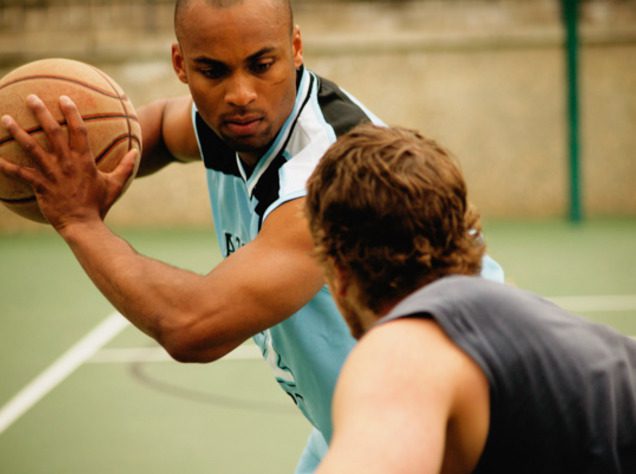Fancy Footwork Is Key
Quick, take a moment to think about some of the NBA’s fastest players, who comes to mind? The Oklahoma City Thunder’s Russell Westbrook? What about the Houston Rockets’ Ty Lawson? Or perhaps you thought of CoachUp’s very own Stephen Curry? What do all these supreme athletes have in common? They’ve got killer crossovers, lethal shooting ability, and a tendency to get into the lane at will — but, none of that is possible without their footwork being on point. When it comes to basketball training, working on your speed and footwork should be an essential part of your workout routine.
)
Face The Facts
Let’s face it, not every basketball player will grow up to be 6’8” and 245 pounds like LeBron James. Players blessed with height and strength will be able to rely on their sheer mass to power through the paint to the basket. Smaller players, on the other hand, will need to rely on their quickness and finesse to explode past larger defenders. When training for the upcoming basketball season, we encourage players of all skill levels to take some time to work on their quickness and agility.
All athletes should try to stay in peak physical condition and this means doing cardio to avoid being winded in the fourth quarter of a big game. However, conditioning by running mile after mile on the treadmill doesn’t translate to being quick and agile on the court. It’s imperative to take the time and work on exercises that help you with lateral quickness.
Jordan Fliegel, CoachUp’s President and Founder who happens to be a pretty impressive basketball coach as well, agrees that fast is the new strong — being quick on the court only adds another element to your game. Basketball is a game of speed, you’re always moving on the court with or without the ball, but many plays can hinge on a five second burst of energy. Most of the time, these bursts will determine the outcome of that offensive possession. He recommends the following drills to condition your body while also improving your explosive footwork. Grab a teammate and run these drills in pairs!
Line Or Box Jumps
(5 sets, 30 seconds per rep)
- Stand underneath the backboard with your feet together, six inches away from the baseline on either side, with your feet parallel to the line.
- On your teammate’s signal, begin hopping back and forth over the line as quickly as possible for thirty consecutive seconds.
- When your teammate yells that the thirty seconds has expired, finish the drill with a full court sprint to the other basket. You can rest when you are timing your teammate during his or her reps.
- When these jumps become too easy, try jumping over an object for extra difficulty.
Box Drill
(5 sets, 30 seconds per rep)
- Take four cones and create a box in the center on the court with each cone five yards apart.
- On your teammate’s signal, you’ll sprint from cone one to cone two, then side shuffle from cone two to cone three, backpedal from cone three to cone four, and then finally side shuffle again from cone four back to cone one.
- You will repeat this process at full speed for thirty seconds and finish off with a sprint to the furthest baseline.
- Again, rest while you time your teammate.
Shuttle Runs
(5 sets at the end of your workout)
- Start in a sprinter’s stance underneath the basket.
- On your teammate’s signal, sprint and touch the foul line with your hand, turn and sprint back to your starting point — make sure you actually touch that line, don’t skimp out on effort!
- Then sprint to half-court and back, then to the far free throw line and back, ultimately finishing by going from baseline to baseline and back one last time.
- Teammates and workout partners should make sure to push each other and cheer one another on.
- Try to beat each other’s times — no one wants to be last!
Ball Drops
(5 sets, 30 seconds per rep)
- Have two players alternate roles — one will have a tennis ball in each hand with arms spread wide and the other will be three feet away in a defensive stance.
- The player with the tennis ball will drop a ball from either hand. Immediately after this, the player in the defensive stance will run to catch the ball before the second bounce.
- The player who caught the ball will run back to the starting position and toss the ball to the other player.
- Switch up the order and number of balls thrown to keep the player guessing.
(Related: Read about the art of the low-post here.)
Huddle Up
Still not convinced? Any elite athlete is constantly working on his footwork — it’s what fuels his ability to quickly change direction, navigate a tight lane, and split a harsh full-court press. Stephen Curry uses it regularly as he loses point guards in a whirlwind of dynamic moves and speeds; and Russell Westbrook uses it as he barrels through an entire team on the way to an emphatic dunk. How you use your new footwork will be up to you, but understand that it’s part of your game that can’t be ignored.
These four simple basketball training drills will, without a doubt, improve your on-court speed. If you stick to these drills, you’ll see a noticeable improvement in your speed, agility, and overall ability on the court.
How useful was this post?
Click on a star to rate it!
Average rating 2 / 5. Vote count: 1
No votes so far! Be the first to rate this post.



